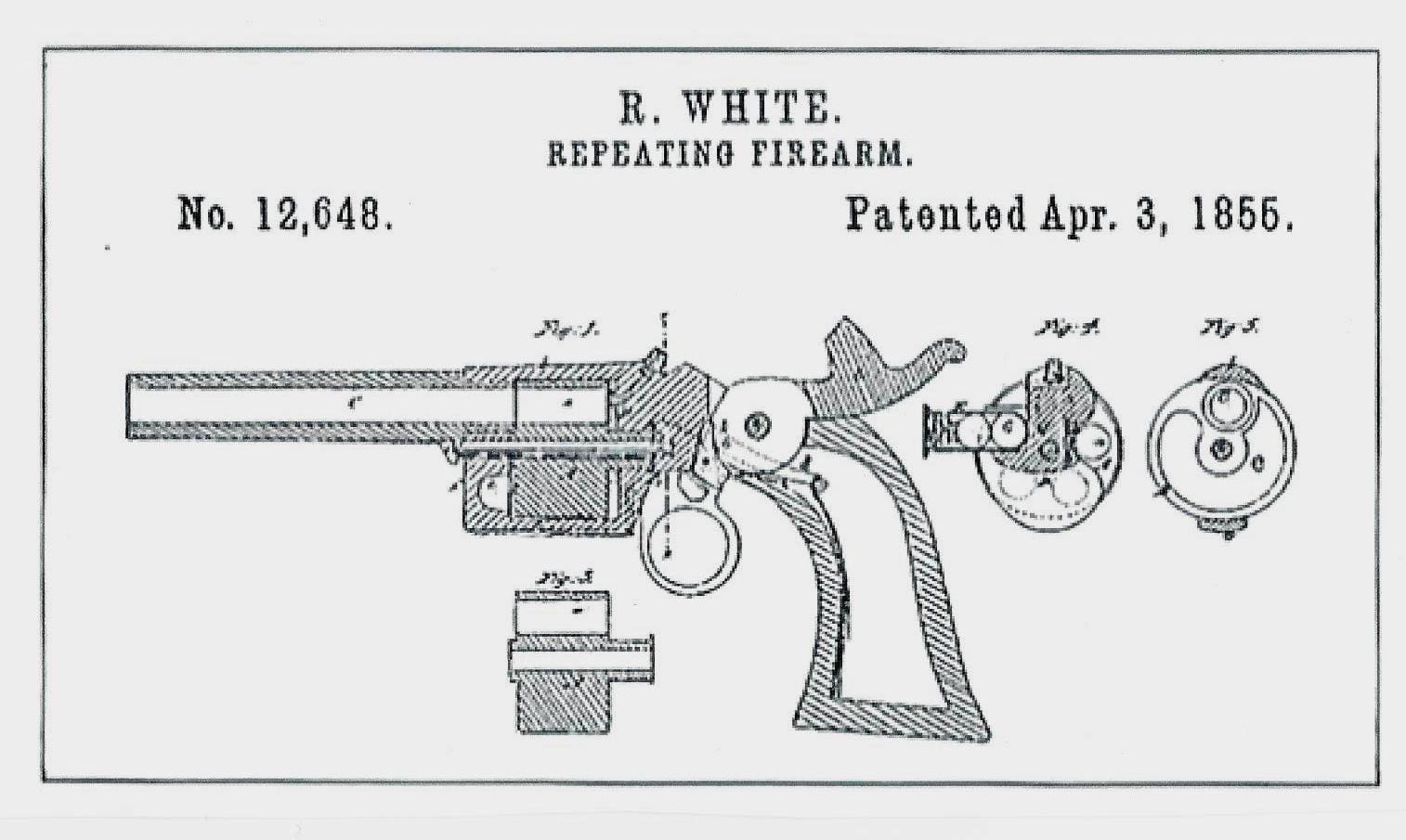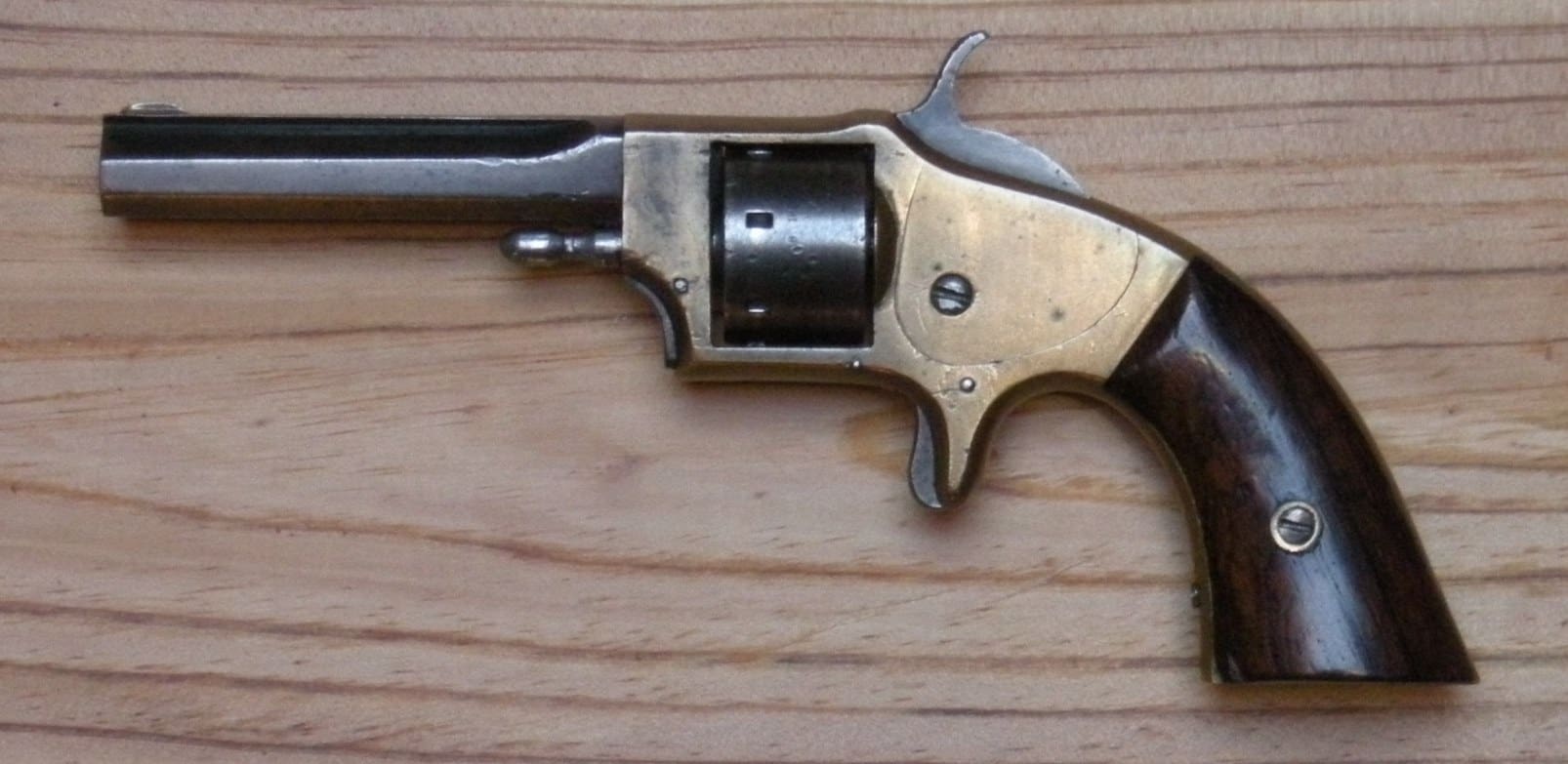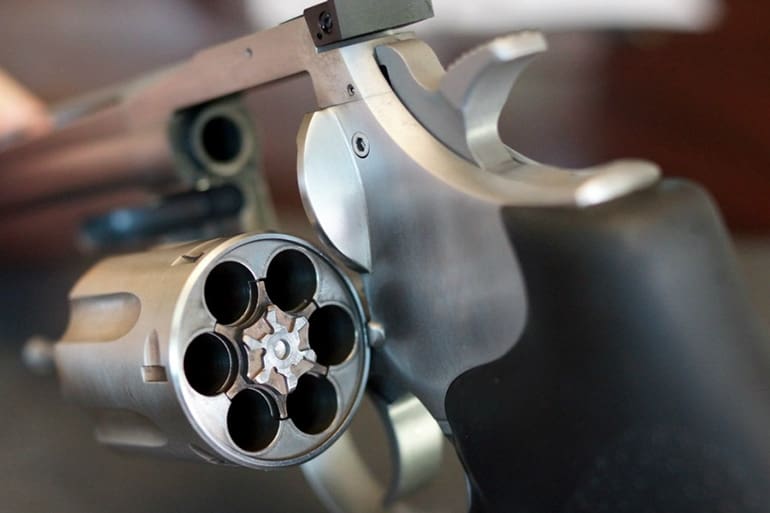Patent infringement is an age-old problem and the firearms industry is not immune to it.
One of the most important design breakthroughs in terms of handgun development was the bored-through revolver cylinder. In 1849, while working for Colt, a man named Rollin White took parts from condemned guns and began experimenting with their cylinder design.
Patented in April 1855, his new design allowed self-contained metallic cartridges to be inserted and extracted with ease from the rear of the cylinder. Since Sam Colt’s cap-and-ball revolvers still reigned supreme (at least until the patent expired a year later in 1856), this was quite the new development, both in terms of arms and ammunition.

White left Colt within a year and licensed his patent to Smith & Wesson. They came to an agreement that paid White 25 cents (almost $7 today) for each revolver they sold using his design.
With the country involved in a civil war and seeing that there would be an increased need for arms, White opened the Rollin White Arms Company about 100 miles from Smith & Wesson. There, he made revolvers under his patent and sold most of them to S&W to keep up with demand.

By 1864, he had sold the business to Lowell Arms Company. They began making unlicensed guns using his design, which infringed on his patent, and White sued them.
This began a long process of litigation between White and Smith & Wesson that involved lawsuits against a large number of small gun manufacturers. Most of the time, White and S&W won the cases.
Sometimes the offending company was forced to pay royalties. Other times, they were bought out and the guns were re-marked with White’s patent info before being sold.
Recognizing that his bored-through design was going to be the way of the future, Rollin White offered to sell his design in 1867 to Colt’s company; his sale price of $1,000,000 (or $15.4M today) was rejected.

One of the key pieces of brilliance on Smith & Wesson’s part in their royalty agreement with Rollin White was that he was responsible for paying his own court costs when it came to defending his patent. So even though S&W was paying White for each revolver they made, most of his royalties were tied up in legal fees.
When he was denied a patent extension in 1870, he decided to petition Congress on the grounds that he hadn’t been fairly compensated by Smith & Wesson under the agreement he signed. It is estimated that Smith had made the modern equivalent of $17.5 million from White’s design and that they had only paid him the modern equivalent of $1.2 million in royalties.
White’s petition passed in both houses of Congress, but was vetoed by President (and former Civil War general) Ulysses S. Grant. One of the reasons Grant cited was from Chief of Ordnance Alexander Dyer, who called White’s patent an “inconvenience and embarrassment” to the military because it prevented manufacturers from creating revolvers with his innovative design during a time of war.
Even though Rollin White had a great design that we still use to this day in revolvers, his bad business deal with Smith & Wesson led to his financial ruin. He gave up on recouping his losses through Congress in 1877 and died in 1892.
Logan Metesh is a firearms historian and consultant who runs High Caliber History LLC. Click here for a free 3-page download with tips about caring for your antique and collectible firearms.





Its time for more 9MM revolvers on the market. Look at the prices of any Smith 547, or Ruger Speed Six in 9MM, prices are way up in space, and that’s not accidental…its because a good midsize 6 shot 9MM is both a great idea, and pitifully absent on the market. Taurus has a great rapid change cylinder arrangement between .38/.357 and 9MM on their new 692 revolver, its just that…its a Taurus, and no thanks. Maybe Ruger or Smith will introduce something similar at SHOT 2020. That rapid change system would be a great idea for top-tier revolver manufacturers to “borrow”…since we’re on that topic. A new Colt King Cobra in 9MM would be a fast seller because its perfectly sized, it would sell even faster if it was convertible to .38/.357.
I agree and would be interested in a 9mm revolver. I already have the Ruger Blackhawk in .45 LC/and .45 ACP and I’ve exclusively shot ACP through it (I wish it was 454 Casull/.45 ACP and then Ruger would really have something.)
I’d be in the market for an affordable quality SA or DA 9mm as I like revolvers but I am unwilling to stock revolver only cartridges like .38 or .357 when semi auto cartridges are more common and accomplish the same powers (excluding magnum revolvers.)
I’m also interested in a lever action carbine/rifle chambered in .308 and holding at least 7 rounds. One that took a 10 round lr/sr mag that didn’t hang down too far would be ideal. Or 7.62×39 as I understand that is pretty close to thurdy thurdy and a hell of a lot cheaper.
Cooter E. Lee,
Communist block 7.62 x 39mm cartridges launch .30 caliber, 125 grain bullets at essentially the same muzzle velocity as .30-30 Winchester’s .30 caliber, 150 grain bullets.
In my world that extra 25 grains of bullet weight on .30-30 Winchester is a fairly significant difference.
Im going from my own limited experience about 7.62×39 vs 30-30 so take everything I say as not necessarily factual.
The 30-30 round is typically blunt nosed so the tip of the bullet doesn’t strike the primer of the cartridge in front of it in a tubular magazine, whereas most 7.62 is fmj or jacketed HP with a pretty decent taper. Out of the muzzle I would expect the 30-30 to hit harder but aerodynamically it has to slow down compared to 7.62 at some distance.
The main consideration for me wanting a lever 7.62 is ammo availability and price so I can shoot it more often for lower cost so I’m pretty indifferent to how it performs ballistically for hunting or defense. 7.62×51 would be ideal but the Browning in .308 only holds 4 rounds. My attitude is that if I only have 4 shots, I might as well have a bolt. Lever guns are just interesting to me.
Madcapp,
I believe (if I am not mistaken, and I could be — please correct me if I am wrong) that there is a fairly significant problem with the idea of a revolver that can shoot both .38 Special/.357 Magnum and 9mm Luger.
The beloved 9mm Luger specification calls for 0.355 inch bullet diameter instead of the .38 Special/.357 Magnum specifications which call for 0.357 inch bullet diameters. The fact that 9mm Luger is 0.002 inches smaller may not seem important. If I understand correctly, that 0.002 inches means that a 9mm bullet doesn’t seal very well in a barrel sized for .38 Special/.357 Magnum and allows quite a bit of propellant gases to escape, which reduces muzzle velocity.
How much does that reduce muzzle velocity? I don’t know. If a revolver with a four-inch barrel bored for .38 Special/.357 Magnum still launches bullets from 9mm Luger cartridges in excess of 900 feet-per-second, that sounds like it is still a useful platform. If muzzle velocity is under 800 feet-per-second, however, that does not sound like a desirable platform unless all you want to do is plink at short range.
That’s a very good question on the technical concerns of a barrel that has to handle both .38/.357 and 9mm, which I cannot fully answer, and am curious about as well. I will tell you this though, if you take a 9MM bullet (now just the bullet only and not the full cartridge) and try to put it into the barrel of a .357 magnum revolver from the back, you can’t do it by hand…its too tight of a fit. Do keep in mind that we’re talking 2 thousandths of an inch difference, and it is clearly possible to handle both…as evidenced by multiple revolvers on the market that come with 2 cylinders including Ruger Blackhawk models 0308 and 0318. It would probably be better to have a dedicated 9MM only design, I’ll agree on that point, and I’d be quite happy with that approach. Also, be aware Korth showed a 9MM conversion cylinder for .357 Smiths, and I’m not sure why that item never materialized. Its worth knowing about though, it would be nice to know more… http://www.gunsholstersandgear.com/2016/01/13/korth-9mm-conversion-for-sw-l-frame-revolver/
SAAMI specifications for the groove diameter of the bores of .380 ACP, 9mm Luger, .38 Special, and .357 Magnum are all identical at .355 inch. Bullet diamater specifications for these calibers range from .355 to .359, depending on caliber and jacketed or lead bullet styles. Of course, there is a couple thousandths of wiggle room in the groove diameter spec, but those are the numbers. The larger bullets are supposed to be swaged down by the forcing cone/leade as they leave the chamber and enter the barrel. Different cylinders/cylinder arrangements would be necessary to accommodate the difference between rimmed and rimless cartridges, but they could all use the same barrel.
I have a Ruger LCR in 9mm that shoots well. Generally has better ballistics than .38 Special and ammo is cheaper. Downside is, it’s easier to operate with moon clips, which can bring along their own baggage.
I seem to recall a brief attempt to make a rimmed 9×19 round for revolvers and their extractors. I think it was called 9mm Federal.
Yes, it was basically a 38 S&W case loaded to 9mm pressure. I heard that some people used it in old 38 S&W break open revolvers and turned then into grenades ans Federal got rid of it because that.
I have a Chiappa Rhino 4″ Dual Cylinder that comes with both .357 and 9mm cylinders. I bought it as an oddity and to practice with cheap 9mm ammo. However the 9mm cylinder doesn’t shoot well. At 7 yds it tends to tear the paper target and is noticeably less accurate than .38 Special. I thought it might be because the barrel twist rate was optimized for .357 but then found an article that noted the .002 size difference. Either way the reality doesn’t live up to the dream of interchangeable cylinders in my experience.
Wish is granted. Next month, after SHOT Show, Rock Island Armory will have the imported AL 9.0 revolver available for sale for an MSRP of $599. It’s a 3 inch barreled, 6 shot 9mm revolver created by Alfa Project from the Czech Republic.
I’m aware of the upcoming RIA / Alfa Proj AL9.0. The whole question there is…availability of aftermarket parts support like grips, sights, or holsters in comparison to something like Ruger or Smith, and long-term availability of service parts, including the overpriced moon clips. I’m not yet certian that the Alfa Proj is a smart buy in the long term, but its certainly something to watch, and a long overdue step in the right direction.
Now what I think would be cool, would be a new take on an old design. Maybe a 9/38/357 Nagant style revolver with the sealing cylinder action. And, thread the barrel of course. I doubt there would be any kind of patent restrictions on a 130 year old Russian design.
Really? You have to use moon clips, and you have to worry about the bullets getting pulled out of the case by recoil– a lot of ammo will fail that way, and tie up the gun (in lightweight guns, obviously).
Those are the reasons there is little demand for 9mm revolvers. Though I agree with you that the short high pressure cartridge is ideal for short barrels. You could really shorten the length of the cylinder with a 9mm vs. a .38. But I wouldn’t give one to a newbie.
“…[Rollins White] decided to petition Congress on the grounds that he hadn’t been fairly compensated by Smith & Wesson under the agreement he signed.[ ] White’s petition passed in both houses of Congress,…”
****
Wow. Back when redresses of grievances were actually received by Congress as actionable petitions. Nowadays everything has to go through the DMV’s Business Model of judicial review, while Congress plays smoke & mirrors with our national budget and looks under stones for reasons to impeach.
Fire every congresscritter who’s up for re-election in 2020. All 435 Reps, and all 33 Senators. Start with completely new blood.
Someone wrote a book about an airliner that solved that problem. It was fiction though.
Good article. I enjoy history. If you don’t know where you came from; how can you know where you are going? A better balance between the political articles and the firearms articles would be appreciated.
Agreed. Current events are necessary and good, as are the product reviews. Even the ‘Sponsored Content’ posts that don’t allow user comments are okay from time to time because we know that TTAG needs to pay the bills to keep the site going.
But it’s always nice to see historical content mixed in as well.
Personal request: I’d like to see a review or two on flintlock muskets, such as perhaps Hawkens models. I’m thinking about expanding my horizons and trying out a DIY yourself kit. Dan?
The article is a good starting point if fairly abbreviated. This video goes a bit deeper if you are interested in this piece of history.
https://youtu.be/11n8GoiMLjc
I too enjoy the Firearm History Articles. Some are things I’ve known, and some I haven’t. Thanks for taking the time and giving a wee break from the current issues, which usually just get me peeved LOL.
Classy choice using a Dan Wesson as the picture sample for the article. I approve.
Look at that top picture. Holes bored through hard steel. If I tried to replicate that with my crummy China-made 8-inch drill press, it would not be easy work…
@Geoff “Bah, Humbug!” PR:
Yeah. My Sear & Roebucks tabletop drill press couldn’t handle that job either. You do realize, of course, that the holes are drilled and finish-bored (and probably reamed as well) BEFORE the steel is hardened. And they have machinery and fixturing to do the job that most of us could never replicate at home.
Great article. I was already familiar with this interesting story but it was great to read it by a different author.
And, amazing there was no mention of the all caps G word anywhere in the article. I was half expecting a quote from Mr, Rollin White, “I know bored-through is great, but toss the revolver and just buy a G____”
The topic is revolvers with bored through cylinders. Why can’t you all stay on subject. Your posts are all over the map.
“The topic is revolvers with bored through cylinders. Why can’t you all stay on subject. Your posts are all over the map.”
You must be new to TTAG.
TTAG doesn’t go all dictator on their comment section. Hang around long enough, and you’ll see it all works out in the end… 🙂
What kind of revolver is shown in the first picture? I ask because I see no cylinder release. Is this just some kind of stock photo that has no release so it can be an “any gun”.
It’s a Dan Wesson Model 715. Cylinder release is in front. In theory this gives more consistent lockup, and Dans are known for their accuracy.
Since the whole cylinder is counterbored instead of each chamber I believe this is one from the Monson Factory.
Ah, thanks.
Thanks.
Also wondering what that revolver is.
“Even though Rollin White had a great design that we still use to this day in revolvers,…”
White’s design was rightfully refused by Samuel Colt. It was unworkable and possibly dangerous. Drilled through chambers in cylinder were kind of coincidental and not a main feature of his intended gun. The $.25 licence fee plus $500 bulk payment (never mentioned in this article) was more than he deserved for his accidental “pearl” feature in “heap of manure” design.
Good observation, that.
White’s patent model drawing is completely unworkable; It actually has a horizontal spring-loaded MAGAZINE to feed the cylinder, but with no mechanism to make it actually function. It wasn’t designed to take metallic self-contained cartridges, but instead was for paper or linen cartridges fired by a single, manually-fitted percussion cap or ‘pill’ placed on an individual nipple (at the top rear of the frame, with a flame channel leading to the top chamber). How those cartridges were supposed to get from the magazine into the cylinder is anybody’s guess.
The only usable feature of White’s patent, which almost certainly shouldn’t have been issued, was for the ‘bored-through cylinder,’ something White didn’t actually ‘invent’. However, the US Patent Office and the courts saw it differently, and S&W was able to milk the patent for all it was worth.
The pinfire revolver used a bored through cylinder. And I seem to recall that it predated the s&W.
Love my wheelguns, and thanks to whomever for the design…
This article is incorrect. Rollin White was bass player for Muddy Waters. It was James Morgan Browning John’s grandpa who made that gunm. Smith and Wesson grabbed it up , cut the hillorally holes ,stuffed it full iof volcanics and history was made
Comments are closed.